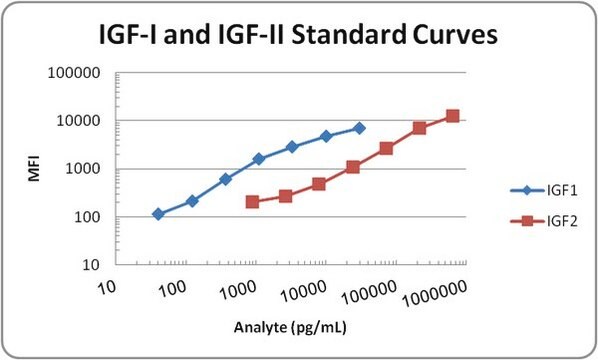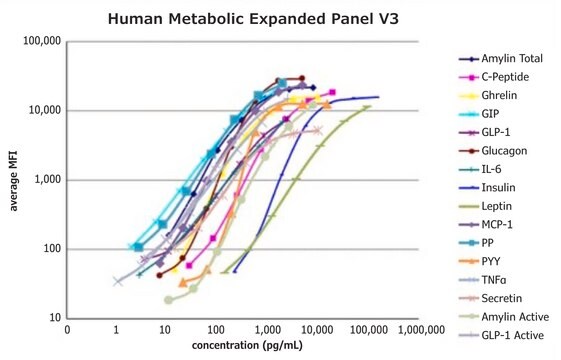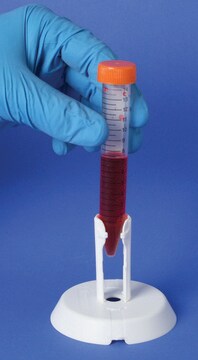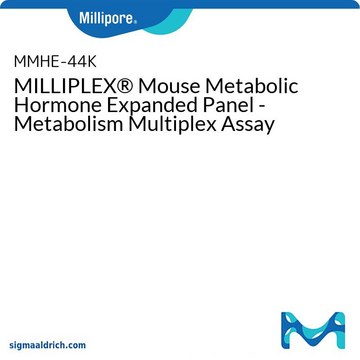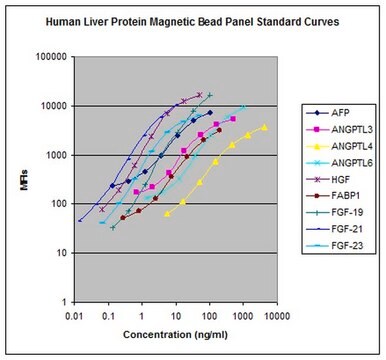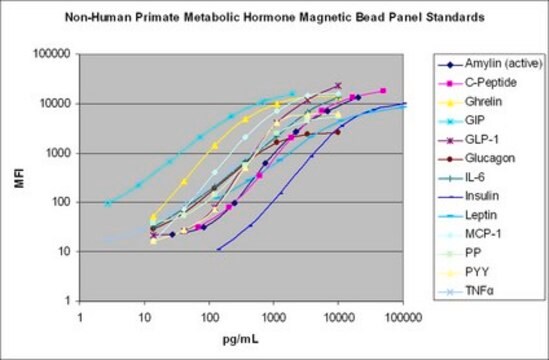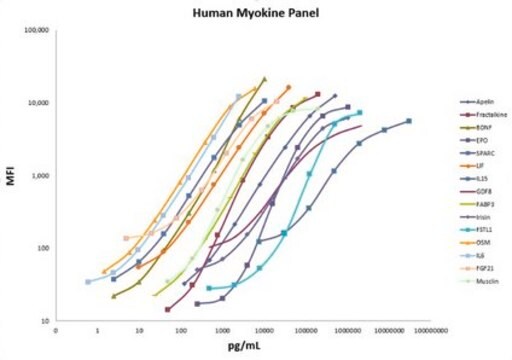HIGFBMAG-53K
MILLIPLEX® Human IGF Binding Protein Magnetic Bead Panel - Metabolism Multiplex Assay
The Human IGF Binding Protein Panel, using the Luminex xMAP technology, enables the simultaneous analysis of 7 IGFBP protein biomarkers in human serum, plasma and cell culture samples.
About This Item
Productos recomendados
Nivel de calidad
reactividad de especies
human
fabricante / nombre comercial
Milliplex®
assay range
accuracy: 79%
(IGFBP-5)
sensitivity: 0.01 ng/mL
(MinDC+2SD; IGFBP-1)
sensitivity: 0.07 ng/mL
(MinDC+2SD; IGFBP-7)
sensitivity: 0.12 ng/mL
(MinDC+2SD; IGFBP-6)
sensitivity: 0.15 ng/mL
(MinDC+2SD; IGFBP-3)
sensitivity: 0.96 ng/mL
(MinDC+2SD; IGFBP-4)
sensitivity: 1.09 ng/mL
(MinDC+2SD; IGFBP-2)
sensitivity: 9.87 ng/mL
(MinDC+2SD; IGFBP-5)
standard curve range: 0.03-25 ng/mL
(IGFBP-1)
standard curve range: 0.07-50 ng/mL
( IGFBP-3)
standard curve range: 0.07-50 ng/mL
(IGFBP-7)
standard curve range: 0.14-100 ng/mL
(IGFBP-6)
standard curve range: 0.34-250 ng/mL
(IGFBP-2)
standard curve range: 0.69-500 ng/mL
(IGFBP-4)
standard curve range: 1.37-1000 ng/mL
(IGFBP-5)
inter-assay cv: <15%
intra-assay cv: <10%
(IGFBP-1)
inter-assay cv: <15%
intra-assay cv: <10%
(IGFBP-2)
inter-assay cv: <15%
intra-assay cv: <10%
(IGFBP-3)
inter-assay cv: <15%
intra-assay cv: <10%
(IGFBP-4)
inter-assay cv: <15%
intra-assay cv: <10%
(IGFBP-5)
inter-assay cv: <15%
intra-assay cv: <10%
(IGFBP-6)
inter-assay cv: <15%
intra-assay cv: <10%
(IGFBP-7)
técnicas
multiplexing: suitable
método de detección
fluorometric (Luminex xMAP)
Condiciones de envío
wet ice
Descripción general
The MILLIPLEX® Human IGF Binding Protein (IGFBP) Panel, is used for the simultaneous quantification of any or all of the following analytes in human serum, plasma, and cell culture conditioned-media samples: IGFBP-1, IGFBP-2, IGFBP-3, IGFBP-4, IGFBP-5, IGFBP-6, and IGFBP-7. This kit uses a 96-well format, contains a lyophilized standard cocktail, two internal assay quality controls and can measure up to 38 samples in duplicate.
The Luminex® xMAP® platform uses a magnetic bead immunoassay format for ideal speed and sensitivity to quantitate multiple analytes simultaneously, dramatically improving productivity while conserving valuable sample volume.
Panel Type: Endocrine
Especificidad
There was no or negligible cross-reactivity between the antibodies for an analyte and any of the other analytes in this panel.
Aplicación
- Analytes: IGFBP-1, IGFBP-2, IGFBP-3, IGFBP-4, IGFBP-5, IGFBP-6, IGFBP-7
- Recommended Sample Type: Human serum, plasma, and cell culture conditioned-media
- Recommended Sample Dilution: For serum and plasma samples, 25 μL per well of a 1:25 dilution should be used when IGFBP3 is not included in the assay. Use a 1:200 dilution when IGFBP3 is included in the assay. Tissue culture supernatants may be run undiluted or appropriately diluted with control medium.
- Assay Run Time: Overnight (16-20 hours) at 2-8°C. For improved sensitivity for some analytes use a 2 hour incubation at room temperature (20-25°C).
- Research Category: Metabolism
- Research Subcategory: Metabolic Disorders
Características y beneficios
Envase
Almacenamiento y estabilidad
Otras notas
Información legal
Cláusula de descargo de responsabilidad
Palabra de señalización
Danger
Frases de peligro
Clasificaciones de peligro
Acute Tox. 3 Dermal - Acute Tox. 4 Inhalation - Acute Tox. 4 Oral - Aquatic Chronic 2 - Eye Irrit. 2 - Skin Sens. 1
Código de clase de almacenamiento
6.1C - Combustible acute toxic Cat.3 / toxic compounds or compounds which causing chronic effects
Certificados de análisis (COA)
Busque Certificados de análisis (COA) introduciendo el número de lote del producto. Los números de lote se encuentran en la etiqueta del producto después de las palabras «Lot» o «Batch»
¿Ya tiene este producto?
Encuentre la documentación para los productos que ha comprado recientemente en la Biblioteca de documentos.
Contenido relacionado
Multiplex immunoassays, such as MILLIPLEX® multiplex metabolic assays, are critical in metabolic syndrome research because they provide a full picture of the different conditions related to it, like diabetes and obesity, as well as save time and sample volume.
Nuestro equipo de científicos tiene experiencia en todas las áreas de investigación: Ciencias de la vida, Ciencia de los materiales, Síntesis química, Cromatografía, Analítica y muchas otras.
Póngase en contacto con el Servicio técnico